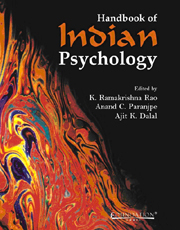Book contents
- Frontmatter
- Contents
- Contributing Authors
- Preface
- 01 Prologue: Introducing Indian Psychology
- 02 Indian Thought and Tradition: A Psychohistorical Perspective
- PART I SYSTEMS AND SCHOOLS
- PART II TOPICS AND THEMES
- 16 Indian Theories of Perception: An Inter-School Dialogue from Buddhist Perspective
- 17 Indian Psychology of Motivation
- 18 Personality in Indian Psychology
- 19 “Giving” as a Theme in the Indian Psychology of Values
- 20 The Making of a Creative Poet: Insights from Indian Aestheticians
- 21 Anchoring Cognition, Emotion and Behaviour in Desire: A Model from the Bhagavad-Gītā
- 22 Consciousness
- 23 J. Krishnamurti: Freedom from Knowledge
- PART III APPLICATIONS AND IMPLICATIONS
- Pronunciation and Transliteration of Sanskrit Alphabet
- Glossary
- Index
20 - The Making of a Creative Poet: Insights from Indian Aestheticians
from PART II - TOPICS AND THEMES
Published online by Cambridge University Press: 26 October 2011
- Frontmatter
- Contents
- Contributing Authors
- Preface
- 01 Prologue: Introducing Indian Psychology
- 02 Indian Thought and Tradition: A Psychohistorical Perspective
- PART I SYSTEMS AND SCHOOLS
- PART II TOPICS AND THEMES
- 16 Indian Theories of Perception: An Inter-School Dialogue from Buddhist Perspective
- 17 Indian Psychology of Motivation
- 18 Personality in Indian Psychology
- 19 “Giving” as a Theme in the Indian Psychology of Values
- 20 The Making of a Creative Poet: Insights from Indian Aestheticians
- 21 Anchoring Cognition, Emotion and Behaviour in Desire: A Model from the Bhagavad-Gītā
- 22 Consciousness
- 23 J. Krishnamurti: Freedom from Knowledge
- PART III APPLICATIONS AND IMPLICATIONS
- Pronunciation and Transliteration of Sanskrit Alphabet
- Glossary
- Index
Summary
The aestheticians of ancient India such as Mammaṭa, Ānadavardhana, Abhinavagupta expressed the opinion that creative achievement can be enhanced or made more probable through the orchestration of many forces. These forces include personality traits and motives, mental capabilities, and some expertise relevant to the field in which creativity is attempted. The right combination of personality traits, creative intelligence, etc. can greatly increase creative potential. Besides these factors, a comprehensive view of life lies at the centre of creative imagination, which illumines or reinforces the particular experiences gathered by the poets and artists from their own lives. A poet or artist has to learn consciously or unconsciously, through reading or otherwise, the art of previous works in the particular genre and choose the elements he considers essential for his own form. He may learn the ways of telling a story or drawing a character if he is a fiction writer or may learn how to paint or draw a line artistically if he is an artist. In this sense he is concerned with the quality of creative imagination in previous works of art. If he is ambitious or curious, he would try to learn from similar works of art not only of the particular place to which he belongs, but also from classical works of art in the world. This re-creative capacity is an element of creative imagination, which indicates the manner in which poets like Kālidāsa, Bānabhaṭṭa, Bhāvabhūti and others assimilated the elements of tradition in their own milieu for using them in their works.
- Type
- Chapter
- Information
- Handbook of Indian Psychology , pp. 383 - 389Publisher: Foundation BooksPrint publication year: 2008
- 1
- Cited by

